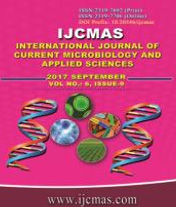


 National Academy of Agricultural Sciences (NAAS)
National Academy of Agricultural Sciences (NAAS)

|
PRINT ISSN : 2319-7692
Online ISSN : 2319-7706 Issues : 12 per year Publisher : Excellent Publishers Email : editorijcmas@gmail.com / submit@ijcmas.com Editor-in-chief: Dr.M.Prakash Index Copernicus ICV 2018: 95.39 NAAS RATING 2020: 5.38 |
Water saving by innovative techniques is essential to prevent salinity and land degradation in paddy production. Therefore, the field investigations were conducted in the farmer’s field under the jurisdiction of the University of Agricultural Sciences (UAS) Raichur during the kharif 2015 and kharif 2016 using randomized complete block design (RCBD) with 7 treatments to determine water requirement of Paddy under different levelling, cultivation practices and irrigation methods for paddy production. The results showed that the dry Direct Seeded Rice (DSR) plot with laser land levelling and subsurface drip irrigation at 60 cm lateral spacing required the lowest quantity of irrigation water of 3872, 2864 and 3368 m3 ha-1, respectively during 2015, 2016 and in pooled mean. The control plot with conventional land levelling using flood irrigation (farmers’ practice) recorded the highest quantity of water usage of 20260, 19112 and 19686 m3 ha-1 during 2015, 2016 and in pooled mean, respectively. The highest per cent water saving was observed in the plot with dry DSR with laser land levelling and sub-surface drip irrigation with 60 cm lateral spacing with 80.89, 85.01 and 82.89 per cent during 2015, 2016 and in pooled mean, respectively when compared with control i.e. farmers’ practice.
 |
 |
 |
 |
 |